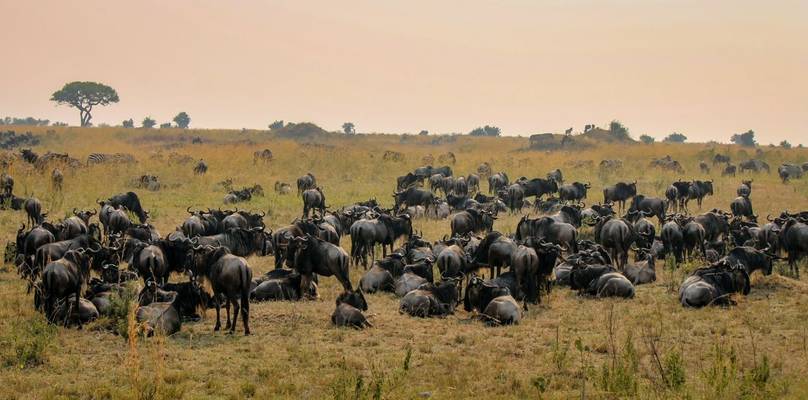Wildlife Holidays in Tanzania's Ngorongoro Crater






There are few places in Africa more dramatically beautiful than Tanzania’s Ngorongoro Crater. From the rim of this extinct, collapsed volcano, visitors can gaze in awe over the plains, forests, marshes and lakes below; these varied habitats support some of the highest densities of large mammals on Earth, including all the members of the famous ‘Big Five’. The crater itself gives its name to the wider Ngorongoro Conservation Area (NCA), an enormous 800,000-hectare landscape where wildlife lives alongside traditional Maasai pastoralists and their livestock. This reserve is part of the epic Serengeti ecosystem and is a stronghold for many rare creatures; furthermore, for several months of the year it plays host to the vast herds of the Great Migration. Also within the NCA is the renowned Olduvai Gorge, where many of the most crucial discoveries about the history of human evolution have been made. Ngorongoro is, quite simply, a place of almost unrivalled variety and fascination.
Speak with our Tanzania’s Ngorongoro Crater specialist

Our Specialist Recommends
Operations Manager - Paul StanburyThe Magic of Tanzania's Ngorongoro Crater
It isn’t just wild animals that make their home here; the greater Ngorongoro Conservation Area was originally established in 1959 as a mixed-use landscape, supporting both conservation and the pastoral livelihoods of the local Maasai people. After the creation of the Serengeti National Park by the British colonial government in 1951, many Maasai were effectively displaced from their land – Ngorongoro was chosen as a place of resettlement where they could continue to practise their centuries-old way of life. Sadly, even today there are controversies over access to grazing land, but the hope is that ecotourism can help to provide substantial benefits to the people who live alongside wildlife.
The history of Ngorongoro is thus intimately linked to the presence of the Maasai and their livestock. In fact, the reserve’s name is actually an onomatopoeic rendering of the sound of clinking cowbells. However, the story of humans in this landscape goes back far beyond that of the Maasai. The NCA contains within it the stunning Olduvai (or Oldupai) Gorge, where fossil remains of more than 60 hominins (the lineage leading directly to modern humans) have been discovered. This gorge, approximately 30 miles long and 90 metres deep, has provided palaeontologists with the most continuous known record of human evolution over the last two million years, as well as the best archaeological history of the development of stone tools. One of the most significant fossil discoveries was that of Paranthropus boisei in 1959; christened ‘Nutcracker Man’ on account of its huge molars (indicative of a vegetarian diet), it was dated to 1.75 million years ago, and provided crucial evidence that the cradle of human evolution was in Africa. More recent specimens of Homo habilis, a species much more similar to modern humans, have also been found.
Besides the gorge, the NCA’s most famous feature is without doubt its eponymous crater, which is the world’s largest intact, inactive volcanic caldera. Somewhere between two and three million years ago, a huge volcano (standing perhaps over 5,000 metres high) exploded and collapsed in on itself, forming a spectacular depression 610 metres deep and 260 square kilometres in extent. Today, the great walls of the crater create a natural sanctuary for wildlife, where a year-round flow of water allows some 25,000 large mammals to thrive.
Amongst these are all the members of the ‘Big Five’ – Lion, Leopard, African Savanna Elephant, African Buffalo and Black Rhinoceros. In fact, the crater is the only place in Tanzania where visitors stand an excellent chance of encountering the full set of Africa’s most sought-after big game. Lions are particularly easy to see here – with a population of around 70 individuals, the Ngorongoro Crater supports one of the highest known densities of these big cats. However, the steepness of the surrounding walls, and the number of settlements located around its rim, limit the movement of individuals between the crater and the surrounding conservation area. This, coupled with the dominance of a few large males amongst Ngorongoro’s Lions, has led to inbreeding and could threaten the future of the species here.
African Buffalo is abundant and resident year-round inside the crater, but the elusive Leopard is more rarely seen – it is most commonly found in the denser forests around the base of the slopes. African Savanna Elephant has, unfortunately, suffered a terrible decline in Tanzania in recent years, with numbers crashing by 60% in just five years from 2009 to 2014. However, they remain relatively well-protected here, and are regularly found in Ngorongoro’s open plains and wooded grasslands.
The decimation of the Ngorongoro Conservation Area’s Black Rhinos was even more dramatic. From an estimated 700 rhinos in the 1970s, poaching brought the number of individuals in the reserve to just 10 by the mid-1990s. Since then, however, dedicated conservation work, including the introduction of new individuals to boost genetic diversity, has seen the number inside the crater rise to around 70 – this is almost half of Tanzania’s total population, and thus Ngorongoro is perhaps the only place in the country where visitors can frequently enjoy the privilege of an encounter.
Common Eland, Hartebeest, Plains Zebra, Blue Wildebeest and Hippopotamus are just a few of the other large mammals to be found in the crater. Interestingly, although Masai Giraffe can be seen in the wider NCA, it is not present in the crater itself – the walls are too steep for it to descend, and there are few of its favourite food trees. In total, some 115 species of mammal have been recorded in the Ngorongoro Conservation Area. Besides the crater, the best areas for game-viewing are the short-grass plains to the north-west, and the area around the shores of Lake Ndutu on the edge of the Serengeti National Park. For a few months each year (usually between December and May), the Ndutu plains support the millions-strong herds of the Great Migration, as gigantic columns of Blue Wildebeest, Plains Zebra and Thomson’s Gazelle, amongst others, make their way south from the Maasai Mara to give birth. This area is also superb for predators, amongst them some rarely seen species such as Serval and Caracal.
Of course, it is far more than the big game that gives Ngorongoro its fascination. Over 550 species of bird have been recorded in the conservation area, with perhaps the most dramatic avian spectacle being the thousands of Lesser Flamingoes usually present on Lake Magadi. Other waterbirds to be found on this crater-floor lagoon include Great White Pelican, Grey Crowned Crane, Cape Teal, African Fish Eagle and African Spoonbill. Away from the water, the area is full of charismatic species, from Livingstone’s Turaco in the forests, through Kori Bustard and Secretarybird in the grasslands to more localised specials like Rufous-tailed Weaver. Between November and April, resident birds are joined by a diverse array of European and intra-African migrants, including European Bee-eater, White Stork and the familiar Barn Swallow. Nevertheless, a visit at any time of year is sure to delight keen birders.
Ngorongoro is a unique destination in Africa. Few places in the world, let alone the continent, offer such a variety of experiences, from the abundance of its wildlife to the richness of its local culture, and from the epic scale of its landscapes to the depths of its ancient history. Especially when combined with the neighbouring Serengeti, a visit to Ngorongoro will provide an experience never to be forgotten.



 Loading search...
Loading search...














